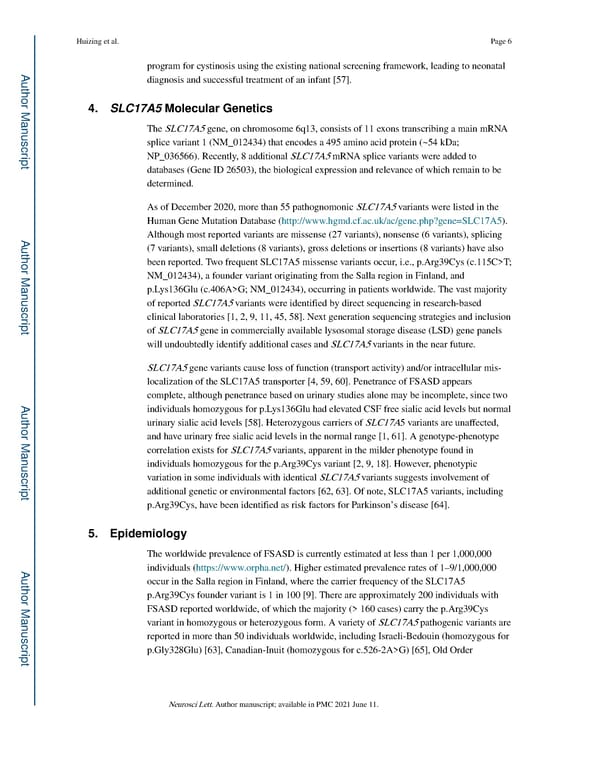Huizing et al. Page 6 program for cystinosis using the existing national screening framework, leading to neonatal A uthor Man diagnosis and successful treatment of an infant [57]. 4. SLC17A5 Molecular Genetics The SLC17A5 gene, on chromosome 6q13, consists of 11 exons transcribing a main mRNA uscr splice variant 1 (NM_012434) that encodes a 495 amino acid protein (~54 kDa; ipt NP_036566). Recently, 8 additional SLC17A5 mRNA splice variants were added to databases (Gene ID 26503), the biological expression and relevance of which remain to be determined. As of December 2020, more than 55 pathognomonic SLC17A5 variants were listed in the Human Gene Mutation Database (http://www.hgmd.cf.ac.uk/ac/gene.php?gene=SLC17A5). Although most reported variants are missense (27 variants), nonsense (6 variants), splicing A uthor Man (7 variants), small deletions (8 variants), gross deletions or insertions (8 variants) have also been reported. Two frequent SLC17A5 missense variants occur, i.e., p.Arg39Cys (c.115C>T; NM_012434), a founder variant originating from the Salla region in Finland, and p.Lys136Glu (c.406A>G; NM_012434), occurring in patients worldwide. The vast majority uscr of reported SLC17A5 variants were identified by direct sequencing in research-based clinical laboratories [1, 2, 9, 11, 45, 58]. Next generation sequencing strategies and inclusion ipt of SLC17A5 gene in commercially available lysosomal storage disease (LSD) gene panels will undoubtedly identify additional cases and SLC17A5 variants in the near future. SLC17A5 gene variants cause loss of function (transport activity) and/or intracellular mis- localization of the SLC17A5 transporter [4, 59, 60]. Penetrance of FSASD appears complete, although penetrance based on urinary studies alone may be incomplete, since two A individuals homozygous for p.Lys136Glu had elevated CSF free sialic acid levels but normal uthor Man urinary sialic acid levels [58]. Heterozygous carriers of SLC17A5 variants are unaffected, and have urinary free sialic acid levels in the normal range [1, 61]. A genotype-phenotype correlation exists for SLC17A5 variants, apparent in the milder phenotype found in uscr individuals homozygous for the p.Arg39Cys variant [2, 9, 18]. However, phenotypic variation in some individuals with identical SLC17A5 variants suggests involvement of ipt additional genetic or environmental factors [62, 63]. Of note, SLC17A5 variants, including p.Arg39Cys, have been identified as risk factors for Parkinson’s disease [64]. 5. Epidemiology The worldwide prevalence of FSASD is currently estimated at less than 1 per 1,000,000 A individuals (https://www.orpha.net/). Higher estimated prevalence rates of 1–9/1,000,000 uthor Man occur in the Salla region in Finland, where the carrier frequency of the SLC17A5 p.Arg39Cys founder variant is 1 in 100 [9]. There are approximately 200 individuals with FSASD reported worldwide, of which the majority (> 160 cases) carry the p.Arg39Cys variant in homozygous or heterozygous form. A variety of SLC17A5 pathogenic variants are uscr reported in more than 50 individuals worldwide, including Israeli-Bedouin (homozygous for ipt p.Gly328Glu) [63], Canadian-Inuit (homozygous for c.526-2A>G) [65], Old Order Neurosci Lett. Author manuscript; available in PMC 2021 June 11.
 Free Sialic Acid Storage Disorder: Progress and Promise Page 5 Page 7
Free Sialic Acid Storage Disorder: Progress and Promise Page 5 Page 7